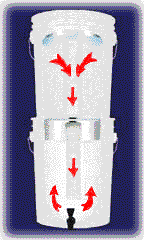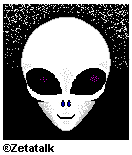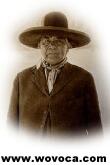Viruses,
Human Error,
Disk Crashes!
Protect your
computer
files before
it's too late.
Try @Backup FREE today.
Click Here
 |

Local
Governments
will not supply
you with
water for very much longer!
click for cheap
emergency water filtration as seen in
Popular Mechanics Magazine |
Aliens? or the "Ant People" who cared for the Hopi?
Native Americans believe there is "duality" -- good and bad --
in everything, and that would have to include
aliens. The Hopi and Pueblo say the "Ant People"
fed and cared for their people while they were living underground,
|
between the 3rd and 4th (our) world, before they reemerged into
the "upper world" at Sipapu, which is in the American
Southwest. |
 |
Are the "Ant
People" back
to help us...
again? |
|
Saudi Arabian authorities recently banned this website
because of their accurate earthquake
predictions.
Learn about
who "they" are,
what the
U.S. Gov't is hiding, the
coming pole shift,
in 2003, how
to prepare, advice
for shelter
safe from
the coming
flooding,
homes,
gardening,
self-reliance, meet
others, information,
etc. |
Let www.Wovoca.com help you get prepared! |
|

Was Jules Verne A Prophet?
By Jan Lamprecht <pbs@iafrica.com>
9-25-00
There is a very strange dimension to works of science fiction which has never
been properly explored.
What are we to make of instances where someone writes a
work of obvious fiction only to discover that some of the fictional facts
therein are later proven to be true?
For example, in 1898 Morgan Robertson published a novel
called "The Wreck of the Titan, or Futility." It described how a transatlantic
luxury liner called the "Titan" sank on its maiden voyage even though it
was reputed to be "unsinkable." In the novel the Titan struck an iceberg
and sank with a great loss of life. Doesn't that story sound
familiar?
The similarities between the fictional Titan of 1898 and
the Titanic of 1912 are stunning as the table below shows:-
Titan Titanic
Month of wreck April April
Passengers & crew 3,000 2,207
Lifeboats 24 20
Tonnage 75,000 66,000
Length 800 ft 882.5 ft
Propellers 3 3
Speed at impact 25 knots 23 knots
-
-
How do we explain this? Perhaps some authors do good research,
and make excellent educated guesses while also having a bit of luck to boot?
Another possibility may be that some authors, while searching for inspiration,
are either consciously or even unconsciously, able to tap into psychic realms
and to write about things which will happen in the future.
-
-
A more subtle question is whether these authors know that
they are psychic, but in order to save themselves from being denigrated by
others, they hide their psychic abilities in works of "obvious fiction" while
privately knowing that there is more realism in their books than anyone (at
the time) would care to believe.
-
-
Consider for example the case of Gulliver's Travels which
is clearly a work of complete fiction about the existence of tiny people
as well as giants. The places mentioned in Gulliver's travels do not exist
- or do they?
-
-
Mars has two small moons orbiting it. They were officially
discovered in August 1877 by the U.S. Naval observatory.
-
-
In Gulliver's Travels, which was published in 1726, in Chapter
III, we find this strange paragraph: "They have likewise discovered two lesser
stars or satellites, which revolve about Mars; whereof the innermost is distant
from the center of the primary planet exactly three of its diameters and
the outermost, five; the former revolves in the space of ten hours, and the
latter in twenty-one and a half."
-
-
Jonathan Swift wrote the above 150 years before the Martian
moons were discovered, The actual facts regarding the Martian moons are as
follows: a) The innermost one, Phobos is at 5,800 miles from Mars as opposed
to 12,300 miles (3 diameters) as Swift said. b) The outermost one, Deimos,
is at 14,600 miles from Mars as opposed to 20,500 miles (5 diameters). c)
Phobos orbits around Mars in 7.2 hours compared to the 10 hours which Swift
wrote of. d) Deimos orbits around Mars in 33.6 hours compared to his prediction
of 21.5 hours.
-
-
Nevertheless, Swift's statements are quite remarkable if
you will consider that these were made 150 years before astronomers confirmed
the existence of these two satellites. The problem with the Martian moons
is that they are extremely small, and that is why they were hidden from
astronomers for so long. The telescopes in Swift's day were just too primitive
to be able to spot these little Martian moons - so how did Swift know they
existed?
-
-
Firstly, there is no known way of inferring beforehand how
many satellites a planet should have. So the mere guess that Mars had two
is of itself quite amazing since the number of moons a planet may have will
vary from none to a dozen or more.
-
-
Secondly, the various measurements given above are not all
that far out. There is no rule which science knows of to predict the distance
of satellites from a planet by theory alone. The orbital times given are
nothing short of staggering. Phobos orbits in 7.2 hours compared with the
10 hours which Swift wrote of. The time for Deimos's orbit is also not that
bad. If you will consider the distances, then note that he predicted that
the innermost one would be at a distance of 12,300 miles - which is very
close to the distance of Deimos (the outermost), which orbits at 14,600 miles!
His biggest error therefore lies in his prediction of the distance of
Phobos.
-
-
Nevertheless, this is completely amazing and has been the
subject of quite a bit of scientific scrutiny in years past. Nobody can
adequately explain the accuracy of Swift's statements. Some have suggested
that maybe Swift was psychic.
-
-
It has been noted that the book "Empire of China", in 1737
mentioned that Mars had satellites. The information for this book came from
a Jesuit missionary who had lived in China. But whether Swift ever had access
to this book or information for it is somewhat doubtful. But even if he did,
there is another problem. The Chinese didn't have astronomical telescopes
at that time or even before then, so how did they know that Mars had two
moons? Chinese astronomy consisted completely of naked-eye
observations.
-
-
Not all knowledge or speculation was accurate either. For
example, in 1744, a booklet was published by E. C. Kindermanns stating that
Mars had a single satellite with a diameter of 1,600 miles. This figure is
completely wrong since Phobos and Deimos are no more than 20 miles in diameter.
So we must still wonder at how Swift managed to get his information so close
to the real facts.
-
-
One possibility is that Swift obtained some educated guesses
from an astute astronomer and then applied some knowledge of gravity and
of Keplers laws of planetary motion to arrive at his conclusions. This is
still highly unlikely because of the extremely small size of the Martian
moons and the backwardness of the telescopes of the day.
-
-
Voltaire, another satirist, mentioned in Chapter 3 of his
"Micromegas" in 1752, that Mars had two moons. What makes Voltaire's statement
even more interesting is that in his book he claimed that the fictional SPACE
TRAVELLERS in his book had seen this! Was he just copying from Swift or was
this another lucky guess?
-
-
There are more questions than answers in this
area.
-
-
Probably the greatest science fiction writer of the past
was Jules Verne. He wrote about people travelling to the Moon. He wrote "20,000
leagues under the sea" which was all about submarines and undersea cities.
But his most famous book was "Journey to the Centre of the Earth" which was
all about the Hollow Earth. Not many people realise that this book was actually
based on the ideas of the Scottish physicist Sir John Leslie who believed
the Earth was hollow.
-
-
Some years ago, Dennis Crenshaw, author of "The Hollow Earth
Insider" wrote a most interesting piece about Jules Verne possibly being
a prophet of some kind. Apparently an unpublished manuscript written by Verne
had been discovered in France. This manuscript was all about the future of
France. It described many things about the France of the future which was
different to the France of Verne's day. It mentioned there being lots of
foreigners in France, and it generally described France in rather dismal
terms. Apparently it was this negative view of the future which caused them
not to publish this manuscript. And yet, the France of today is very much
like the France which Verne described.
-
-
If one looks at everything Verne wrote then we notice that
all of it has come true, except for "Journey to the Centre of the
Earth."
-
-
For example, submarines are commonplace. Although we don't
have undersea cities yet, they will probably still come. The science to build
them is already there. The only reason this has not yet been done is because
there is no pressing need for them yet. But this could still
happen.
-
-
More prophetic was his writing of a journey to the Moon.
It has been noted that there are a great number of similarities between the
Moon trip he described and that which was actually took place in 1969. He
even got the speeds and times relatively close to the actual times taken.
Quite a bit has been written about the similarities between his science fiction
and the actual events.
-
-
This brings us to "Journey to the Centre of the Earth."
This is, to my knowledge, the only work by Jules Verne which has never come
true. Yet, quite a lot of what Verne wrote might actually be true. For example,
in Chapter 14 of Hollow Planets, I mentioned Lake monsters, such as the Loch
Ness monster. I pointed out that real scientists, like Prof Roy Mackal, had
actually been within a few feet of this creature. Various evidence exists
to show that this creature is a plesiosaur - a remnant of the dinosaur age.
But why are these creatures never caught? I went on to suggest that a herd
of such creatures may exist in subteranean caverns and lakes and that they
have several underground feeding places. From time to time one or more of
these creatures may wander out into Loch Ness for a time before returning
to their normal habitat.
-
-
This idea is very consistent with the facts. At times, one,
two or more of these creatures have been seen on sonar in Loch Ness. At other
times the entire Loch has been scoured and not a single animal could be found.
The secret would be to find the underwater passageway through which they
enter and exit.
-
-
I found various evidence to suggest that Verne's ideas of
underground lakes and perhaps even oceans is quite possible. So we may already
have the beginnings of the evidence which will show that Verne's writings
are more prophetic than we may at first appreciate.
-
-
It makes me wonder whether, in the next century or so we
might see him being proven correct once more. If so, it would be completely
uncanny. I can't help wondering if Verne was psychic, but perhaps, to prevent
himself from being ridiculed, maybe he wrote everything as science fiction.
It would indeed have been a wise course of action.
|











![[Image]](pict41.jpg)
![[Image]](pict43.jpg)